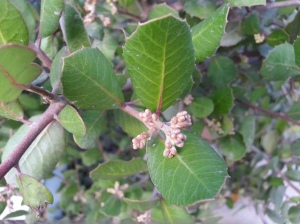- Common Name: Lemonade Berry
- Kumeyaay: Huusill (if red berries) or Huutat (if orange berries) (Shipek 1991:95)
- Luiseño: Shoval (La Jolla Band of Luiseño Indians 2008)
- Categories: Food, Arts and Crafts

Overall picture of Rhus integrifolia (Lemonade berry) at the Mission Trails Regional Park. Photo by Sara Milne.
Rhus integrifolia, commonly known as the lemonade berry, is typically found on the coast and in the foothills from Santa Barbara County to Baja California (Lightner 2011:63; Clarke 1977:52). Lemonade berry is generally a rounded bush that can grow quickly to one to three meters in height (Clarke 1977:52). Lemonade berry has “sap heavy wood, long branches, and dark green, leathery leaves” (Lightner 2011:63). The leaves themselves are relatively small, being about “2.5-5 cm long, 2-3 cm wide” (Clarke 1977:52). Its flowers are either pink or white and its fruit is both sticky and tart (which according to Lightner, inspires its common name) (Lightner 2011:63). It tends to bloom between February and May with its fruit following shortly after (Clarke 1977:52).
The lemonade berry is important for wildlife (including many birds such as the crow, cactus wren, and scrub jay and even mountain sheep) as it is used for both food and cover; it is also well-liked by people for native plant gardens or simply because it grows quickly, is robust, has beautiful green coloring, and is “drought resistant” (Lightner 2011:63; Clarke 1977:54). Among native peoples, including the Kumeyaay and Luiseño, lemonade berry has been primarily used for its berries, specifically to make a drink (Shipek 1991:95). Depending on the color of the berries, according to the Kumeyaay, it is either called “huusill” if the berries are red or “huutat” if the berries are orange (Shipek 1991:95). According to Lightfoot and Parrish (2009:267), the berries were prepared by being “pounded, dried, and winnowed” and then eaten. Some say that the berries were eaten without being cooked (Timbrook 2007:166). There could be some discrepancies in how the berries were used or perhaps different peoples used them in different ways. Defina Cuero states that the Kumeyaay either ate the berries fresh or soaked in water to obtain a flavored water (Shipek 1991:95). Cuero also says that the Kumeyaay would use the lemonade berry to “quench their thirst on long journeys” by placing the leaves in the corner of their mouths (Shipek 1991:95). In addition to the berries, the Kumeyaay also ground the seeds to make a tea to drink if they were sick and used the bark to make another tea to drink “after a baby was born” (Shipek 1991:95). According to Dr. Rebman, from the San Diego Natural History Museum, the Luiseño used the lemonade berry not only as a drink but they also used the stems of the plant in basketry (La Jolla Band of Luiseño Indians 2008).


